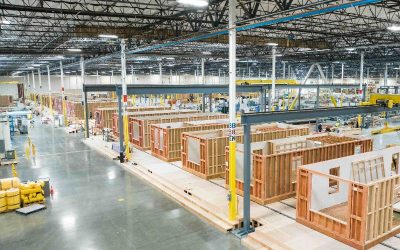Vertex BD Startup and Implementation — Blog 1: Introduction to BIM and What It Can Do for Your Company
As an executive for a leading BIM company, I am obviously a proponent of the technology, as are most architectural, engineering, and construction (AEC) professionals, and I see a lot of articles about BIM making a positive impact at the macro level around the world.
- Blog Post
- September 2023

- Pekka Moilanen
- Marketing Director
“In the world of architecture, engineering, and construction, technology has continuously played a vital role in shaping the way projects are designed, planned, and executed. One such technological advancement that has transformed the construction industry is Building Information Modeling (BIM). BIM has revolutionized the way buildings and infrastructure are created, managed, and maintained, offering numerous benefits and improving project outcomes.”
– American Institute of Architects, AIA Contract Documents
Prominent professional and public-sector organizations, including the AIA and Project Management Institute (PMI), as well as some of the largest AEC firms in Europe and beyond are advocating for increased adoption of BIM.
Even with such positive indications at the macro level, it can be difficult to quantify exactly what BIM can do for a given organization and what adopting BIM actually looks like.
In this blog series, I aim to drill down to the micro level and explore what adopting BIM might mean for a particular company in a given sector. Over the next several months, I’ll post a series of blogs designed to walk people who are new to BIM software through the benefits and potential impacts of implementing it.
Let’s start by answering some basic questions to make sure we’re all on the same page.
What is BIM, and why is it getting so much press?
According to the AIA, BIM is “a collaborative process, allowing multiple stakeholders and architecture, engineering, and construction (AEC) professionals to work together on the planning, design, and construction of projects through a 3-D model. It provides a real-time update at each stage of the process.”
I would clarify that BIM is a software product that facilitates and automates this collaborative process and that, when done well, it features an intuitive user interface that allows the user to experience the space being built as it’s designed.
Simply put, BIM is one of the most important technology developments for the AEC industries in decades.
How common is BIM in the AEC industry?
A 2021 article in Arch Daily described the accelerating global adoption of BIM and that it is quickly becoming a standard design tool for the AEC industry. Germany, Scandinavian countries, the UK, and the U.S. are at the leading edge, and BIM is being rapidly implemented in many other countries, including Brazil, Canada, Chile, Colombia, France, and Peru. In the UK and a growing list of other European countries, BIM is mandatory for many publicly funded projects.
What are the biggest benefits of BIM for AEC companies?
Adopting BIM offers tremendous benefits to AEC companies, including:
- A comprehensive overview of a construction project from start to finish
- Enhanced collaboration and coordination between designers, contractors, and owners
- Reduced costs due to fewer design errors and less rework
- Increased predictability in project schedules
- Improved safety
The sum of these benefits is that BIM reduces risk for AEC companies and their clients while helping them to operate more profitably.
What’s the best way to start thinking about a BIM platform?
While the benefits of BIM software are compelling, the process of selecting a platform and thinking through implementation and potential return on investment (ROI) can seem arduous in the beginning.
Adopting BIM is an AEC-specific example of digital transformation, which McKinsey defines as the “fundamental rewiring of how an organization operates.” When an AEC company adopts BIM, essential processes that have always been analog become digitally enabled and automated.
It’s crucial for business leaders to first have a clear understanding of what BIM can do for their company and what their desired business outcomes are. With that information in hand, they should then consider the options available and how well they align with the company’s specific use cases and market sectors.
What’s the next step?
Stay tuned and follow along for this blog series!
This series will walk AEC organizations and other interested parties through the decision-making process for selecting and implementing a BIM platform. I will shed some light on why so many companies are implementing BIM, and I will also highlight some of the best use cases for BIM and share some of our customers’ success stories. Over the next few months, this blog series will address the following topics:
- What can BIM do for your company?
- Why Vertex BD?
- In What Sectors Is Vertex BD Most Useful?
- ROI: What Results Can You Expect?
I look forward to discussing each of these topics with you. While I believe Vertex’s BIM products offer exceptional value to our customers, and we of course hope to earn your business, that isn’t my primary goal for this blog series. I hope to demystify the process of selecting and implementing a BIM tool and help those new to the industry gain a foothold and make the best decision for their company.
I look forward to your comments and questions on LinkedIn.
Related Stories
Best 3D construction software for professionals
Best 3D construction software for professionals 3D construction software has become a cornerstone of modern building projects, fundamentally transforming traditional construction practices. By enabling architects, engineers, and builders to create highly detailed,...
Leading construction design software for professionals
Leading construction design software for professionals In the ever-evolving construction industry, construction design software has become indispensable for streamlining workflows, enhancing accuracy, and improving collaboration. Among the available options, Vertex BD...
What is modular building design? – Unlock efficiency and precision
To fully unlock the potential of modular building design, it’s essential to utilize advanced tools that streamline the process from design to construction. While modular construction already offers significant advantages like faster timelines and cost savings, a tool like Vertex BD takes it further by integrating design and manufacturing into one seamless platform.




